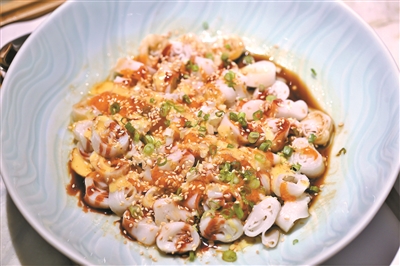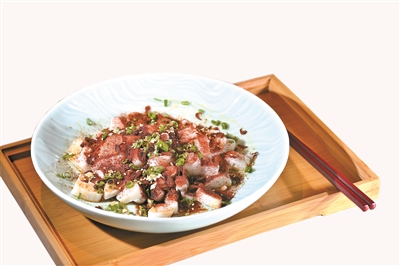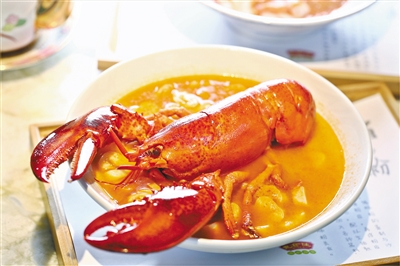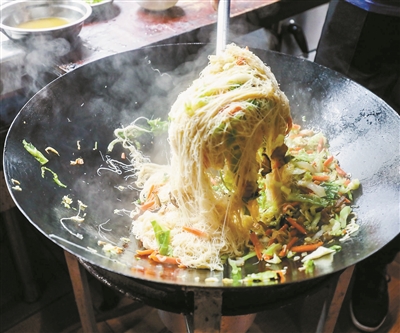



Text, Figure/Guangzhou Daily All-Media Reporter Zeng Fanying (except signature)
In the uncertain summer, the mood and appetite are also good and bad. The attraction of big fish and big meat has dropped sharply, and a refreshing snack is more appetizing, which can not only satisfy the appetite, but also add no burden. Friends in the south have a special liking for rice, and eating food in the past dynasties has opened their minds and eaten rice out of a snack menu. Don’t look at the tiny grains of rice, but its changing power is endless. Those white rice snacks add a little comfort to the noisy summer stomach.
A taste of rice rolls.
Presumably, every Guangzhou native or friend living in Guangzhou is very familiar with Pig rice rolls, which is an indispensable snack for primary school students and a unique snack in Guangzhou. Friends from other places should never think that "rice rolls the Pig" is a part of the pig. In fact, it is a rice product, which is as round as a pig’s intestines. The wise Guangzhou people take shape and meaning and give it such an image nickname. In Guangdong, Guangxi and Southeast Asia, Pig rice rolls is also called Fenjuan, Fenjuan, Pig Intestines, rice rolls and so on.
Rice rolls, a pig, has the same ancestry as LaChang, and is made by grinding rice into pulp and then steaming it. However, the history of pig rice rolls is longer than diarrhea. Pig rice rolls and another rice product, Seto, are the most traditional powder snacks in Guangzhou. Wonton Noodles and Tanghe noodles came into being later.
Recently, there is a special pig rice rolls restaurant in Dongfeng East Road, which has an ethereal name: Running Water Gu Xiang. Opening the menu, the eighteen ways of eating pig rice rolls were recorded on it, which greatly refreshed the diners’ cognition of pig rice rolls. In terms of cutting method, the master of running water Gu Xiang has three treatment methods: traditional cutting, thick cutting and thin cutting. Thick cutting is oblique cutting and thin cutting is vertical cutting, which is more conducive to achieving the purpose of flavor in post-production. For each cutting method, the chef developed corresponding cooking methods, including soup cooking, fishing, frying and dipping.
Rice rolls, who eats pigs, is also rich and thrifty. There are rice rolls, a traditional three-sauce pig, rice rolls, an expensive shelled lobster pig and rice rolls, a super rich shrimp pig, rice rolls, a chicken-claw pig with abalone sauce, and rice rolls, a spicy bullfrog pig that highlights the spicy Sichuan cuisine.
Xinghua rice noodles are as fine as silk and fragrant.
Rice is ground into pulp, the rice pulp is steamed into powder, the powder is cut into filaments and dried, which is Xinghua rice flour, a famous local product of Putian, Fujian Province. It was listed in the second batch of intangible cultural heritage list of Putian City in 2009. As thin as hair, as thin as 1~2 mm, with rich rice flavor, this is the characteristic of Xinghua rice noodles.
A few days ago, the reporter went into the local rice noodle processing factory in Putian to learn more about the production process of Xinghua rice noodles. According to Guo Xueming, the general manager of Berry Factory, which produces Xinghua rice noodles, Xinghua rice noodles originated in the Northern Song Dynasty. The early Xinghua rice noodles were relatively rough, and after numerous improvements, they became fine and loose today. The whole production process has many steps and a long process, including rice washing, pulping, drying, cooking fruit (semi-cooked), reef fruit, silk pressing, cooking powder, cutting, washing powder, rice handle and drying. At present, the annual output of their factory reaches 3000 tons.
"In the past, rice noodles had to be dried for a day. It was necessary to have enough sun exposure and wind to make rice noodles flexible." Guo Xueming picked up a piece of rice flour and kept arguing. The reporter tried it, but it still kept arguing. He said that on the one hand, because of the raw materials, the selected rice should be strong enough to be tough, not easy to break and not easy to paste when cooked; On the other hand, thanks to processing technology.
Xinghua rice noodle is a choice for local breakfast. Every morning, the shopkeeper opens the shop early, grinds the soybean milk, prepares the rice noodles, and cooks them when the guests come. Local people will add a small amount of soybean milk when frying rice noodles. When collecting juice, rice noodles are full of bean flavor, and rice and bean flavor are combined, which is dry and fragrant. Air-dried rice noodles don’t need to be soaked in advance, just add a little water or soybean milk when frying. When frying, it needs a big fire and oil, and the shovel will fall quickly.
In Putian restaurant in Guangzhou, they also used Xinghua rice noodles from their hometown, but interpreted the rural flavor in their own way. According to the chef’s introduction, stir-fry pork belly shreds and onions in a hot pan, add dried shrimps and stir-fry shredded Chinese cabbage until soft, then stir-fry with crispy shredded Chinese cabbage, dried scallops, shredded red onion, dried bean curd and celery, then add water, shrimp balls, flower shells and so on to make a delicious taste, and add Xinghua rice noodles for stewing, drying, steaming and taking out of the pan.
Rice rolls, a pig with three sauces: rice rolls, a pig with three sauces, is a traditional way of eating, but the sauce has been improved by the chef, not limited to three sauces. It is made of peanut butter, yellow mustard sauce, sweet sauce, garlic Chili sauce and soy sauce, and diners can add it by themselves, and the taste is strong or light, which is under their control.
Rice rolls, a shrimp and shrimp seed pig: The special ingredients of Guangfu are naturally in line with rice rolls, a pig. Shrimp seeds are mostly found in Wonton Noodles of Guangfu, and river shrimp is a seasonal ingredient of Guangfu, which is used by chefs in rice rolls of pigs, so there are rice rolls, a shrimp and shrimp seed pig, and rice rolls, a river and shrimp pig with ginger, onion and soy sauce. These are all ancient elements that cherish each other. Guangfu dim sum and spicy Sichuan cuisine are also integrated into this roll of pig rice rolls, and rice rolls with abalone sauce and chicken feet and rice rolls with spicy bullfrog are born.
Rice rolls the Lobster Pig: The most gorgeous pig in rice rolls is rice rolls the shelled lobster pig and rice rolls the super rich shrimp pig. Lobster or rich shrimp are all served, across the bowl surface, domineering and leaking sideways. The soup base of rice rolls, a lobster pig, is boiled with sea shrimps. After the lobster is fried, it is made into thick juice together with the lobster shell. The sea shrimp soup and the whole lobster juice are smelted in one pot, which makes the soup base invincible. Re-heated and splashed into the steamed thin-cut pig rice rolls, the fragrance of shrimp instantly penetrated into every cell of pig rice rolls. The advantages of thin cutting are revealed here, and it is the most suitable for making soup.
关于作者